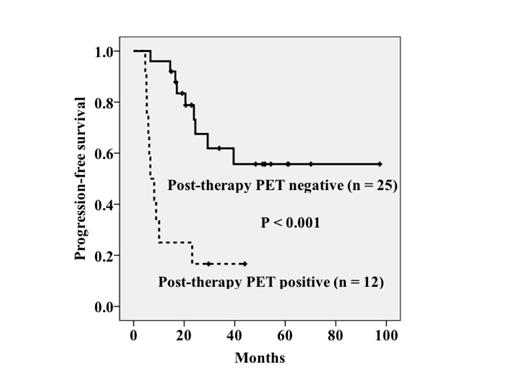Abstract
Positron emission tomography (PET) is being increasingly performed for evaluation of the therapeutic efficacy (post-therapy PET) after lymphoma treatment. Although post-therapy PET is effective in predicting the outcome in 18F-fluorodeoxyglucose (FDG)-avid lymphomas such as Hodgkin lymphoma and diffuse large B-cell lymphoma, its efficacy in predicting the outcome for peripheral T-cell lymphomas (PTCLs) is not fully elucidated. Hence, we evaluated the association between the results of post-therapy PET and prognosis in patients with PTCLs.
Of the 57 patients with PTCLs (peripheral T-cell lymphoma, not otherwise specified [PTCLnos] and angioimmunoblastic T-cell lymphoma [AITL]) who underwent first-line treatment in 5 hospitals of the Yokohama City University Hematology Group between 2005 and 2011, we enrolled 37 patients who were evaluated by post-therapy PET in this study. The histological diagnoses were PTCLnos in 16 cases and AITL in 21 cases. All 37 patients received adriamycin (ADR)- or THP-ADR (THP)-containing chemotherapy with curative intent. Of these, 2 patients received involved-field radiotherapy as a part of first-line therapy. For the evaluation of post-therapy PET, images were interpreted by local nuclear medicine physicians and detailed reports were prepared. The association between the results of the post-therapy PET and outcome of the patients was evaluated.
The study population comprised 19 men and 18 women. Their median age was 63 years (range 16-83 years), and the median observation period among the surviving patients was 42 months. According to the International Prognostic Index (IPI), 7 (19%) patients were at low risk, 11 (30%) were at low-intermediate risk, 12 (32%) were at high-intermediate risk, and 7 (19%) were at high risk. The distribution of prognostic index for T-cell lymphoma was 5 (14%) in group 1, 12 (32%) in group 2, 15 (40%) in group 3, and 5 (14%) in group 4. At presentation, 15 (41%) patients had B symptoms and 6 (16%) showed bone marrow involvement. None had a bulky mass with a >10-cm diameter in the horizontal section. First-line treatment included CHOP, THP-COP, THP-COP followed by involved-field irradiation, and biweekly THP-COP in 6, 22, 2, and 7 patients, respectively. None of the patients received up-front stem cell transplantation. At presentation, 27 patients underwent PET, of which and 26 (96%) showed positive results. Of the 37 patients who underwent post-therapy PET, 12 (32%) showed positive results and 25 (68%) showed negative results. The 3-year progression-free survival rates in the positive and negative post-therapy PET result groups were 17% and 62%, respectively (P< 0.001) (Figure). Ten of the 12 post-therapy PET patients showing positive results experienced PD (positive predictive value, 83%), while 16 of the 25 patients showing negative results did not experienced PD (negative predictive value, 64%). The 3-year overall survival rates in the positive and negative post-therapy PET result groups were 46% and 84%, respectively (P = 0.044). All of the 9 patients died during the observation period due to lymphoma.
Post-therapy PET predicts the outcome in patients with PTCLs (PTCLnos and AITL).
No relevant conflicts of interest to declare.
Author notes
Asterisk with author names denotes non-ASH members.


This feature is available to Subscribers Only
Sign In or Create an Account Close Modal